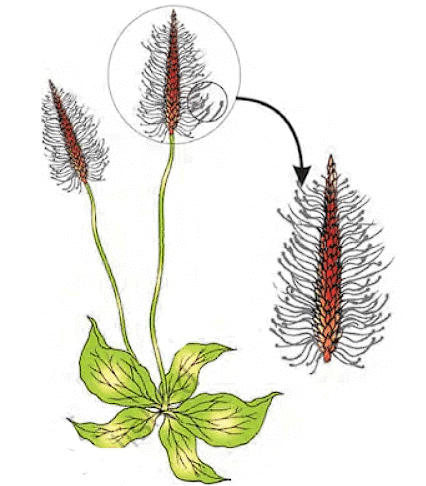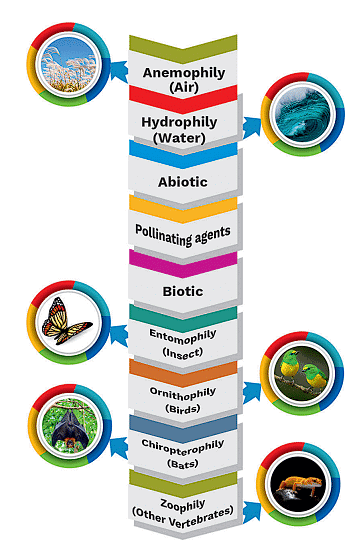Pollination and Outbreeding Devices | Biology Class 12 - NEET PDF Download
| Table of contents |

|
| What is Pollination? |

|
| Types of Pollination |

|
| Agents of Pollination |

|
| Out Breeding Devices |

|
| Pollen- Pistil Interaction |

|
| Artificial Hybridsation |

|
What is Pollination?
Pollination is defined as the process of transfer of pollen grains from the anther to the stigma of the same flower or of a different flower of the same species.
 Pollination
Pollination
Types of Pollination
Pollination can happen in different ways: inside one flower, between flowers on the same plant, or between flowers on different plants. Based on this, there are two types of pollination

1. Self Pollination
Self-Pollination or Autogamy: If the pollen grains are transferred from an anther to the stigma of the same flower, or different flowers of the same plant is called Self-pollination or Autogamy.
Conditions for self pollination
(a) When the pollen is ready to come out of the anther, the stigma should be ready to catch it. It's like making sure the right parts are ready to do their jobs at the same time.
(b) When the anther and stigma need to be close to each other. If they're far apart, the pollen might not reach the stigma, and pollination won't happen. So, being close helps the pollen to easily move from the anther to stigma.
- In normal flowers where the reproductive parts are fully exposed, complete self-pollination is not very common. For self-pollination to happen in such flowers, the timing of pollen release and stigma condition must match, and the anthers and stigma should be close to each other.
- However, some plants like Viola, Oxalis, and Commelina have two types of flowers: chasmogamous flowers with exposed reproductive parts similar to other plants, and cleistogamous flowers that never open up.
- In these flowers, the anthers and stigma are positioned close together. When the anthers release pollen inside the flower buds, the pollen grains directly touch the stigma, causing pollination to occur. As a result, cleistogamous flowers consistently self-pollinate because there's no opportunity for pollen from other plants to land on the stigma. Cleistogamous flowers can reliably produce seeds even without the help of pollinators.

2. Cross pollination
Cross-Pollination or Allogamy: When the pollen grains are transferred to the stigma of other flowers of the same species is called Cross-pollination or Allogamy. It takes place in between two different flowers.
Cross-pollination is of two types:
(i) Geitonogamy: Geitonogamy is when pollen moves from the anther of one flower to the stigma of another flower on the same plant.
Note: Even though it looks like cross-pollination and involves a pollinator, it's actually similar to self-pollination because the pollen comes from the same plant.
(ii) Xenogamy: This type of pollination involves pollen moving from the anther of one plant to the stigma of a different plant. It's unique because it's the only way that genetically different pollen grains reach the stigma during pollination.
Agents of Pollination
Plants depend on three main methods for pollination: wind, water, and animals. Most plants use animals for pollination, while only a few use wind or water. In wind and water pollination, there's a random chance of pollen grains touching the stigma. To cover for the chance that some pollen might not reach where it needs to go, flowers make a more pollen than they actually need.1. Wind Pollinated Plants
Wind pollination is most common among non-living methods of pollination.
Conditions for wind pollination to occur:
- Pollen needs to be light and not sticky so it can be carried by the wind.
- These flowers usually have stamens that stick out well, making it easy for pollen to be blown away by the wind. They also have big, feathery stigmas to catch the pollen floating in the air.
 Wind pollinated- Exposed stamens
Wind pollinated- Exposed stamens
- Wind-pollinated flowers often have one seed in each seed container and many flowers bunched together. A good example is corn: the tassels you see on top are the parts that catch the pollen from the wind. Grasses often use wind for pollination too.
 Corn Cob Tassels
Corn Cob Tassels
2. Water Pollinated Plants
Water pollination is rare in flowering plants, mainly seen in about 30 genera, mostly monocotyledons(These plants are characterized by having one cotyledon). Lower plant groups, like algae, bryophytes, and pteridophytes, often use water to transport male gametes.
Note: Bryophytes and pteridophytes, which are small plants, are not able to spread to new areas because they depend on water to transport their seeds and support their growth. Without sufficient water, their ability to reproduce becomes limited, resulting in their presence being restricted to fewer locations.
- Examples of water-pollinated plants include Vallisneria, Hydrilla, and marine sea-grasses like Zostera.
- Not all aquatic plants use water for pollination; many, like water hyacinth and water lily, are pollinated by insects or wind.
In Vallisneria, a type of aquatic plant, the female flowers have long stalks that reach the water surface. Meanwhile, the male flowers release pollen grains onto the water's surface. These pollen grains are then carried by water currents to reach the female flowers for pollination.
 Pollination in Vallisneria
Pollination in Vallisneria
In some other water-pollinated plants such as seagrasses, the female flowers remain submerged underwater. In these plants, the pollen grains are released into the water. They are then passively carried by water currents until they reach the stigma of the female flowers, where pollination occurs.
To protect the pollen grains from getting wet and potentially becoming ineffective, many water-pollinated species have a protective coating of mucilage. This mucilaginous covering helps to keep the pollen grains dry and viable while they are carried through the water to their destination for pollination.
3. Insect Pollinated Plants
Most flowering plants use a variety of animals to assist with pollination, including insects like bees, butterflies, flies, beetles, wasps, ants, moths, birds such as sunbirds and hummingbirds, and bats. Insects, particularly bees, are the primary pollinators, although larger animals like primates, tree-dwelling rodents, and reptiles have also been known to pollinate certain plants.
Flowers of animal-pollinated plants are commonly specialized to attract a specific species of animal.
 Pollinating Agents
Pollinating Agents
Conditions of Insect Pollinated Plants
(a) Insects like to visit flowers that are big, colorful, and smell nice. These flowers often have sweet nectar inside. When small flowers are around, they tend to grow close together in bunches so insects can easily find them.
(b) Animals, like insects, are attracted to flowers because of their colors or smells. Some flowers even release bad smells to attract flies and beetles.
(c) When animals visit these flowers to get the nectar, they accidentally touch the flower's anthers and stigma. Their bodies get sticky pollen grains from the flower. Then, when they visit another flower, the pollen sticks to the stigma, leading to pollination.
Note: Sometimes, flowers provide safe spots for animals to lay eggs.
For example, the tall flower of the Amorphophallus plant is like a home for egg-laying.
Similarly, a certain type of moth and the Yucca plant have a special relationship. The moth lays its eggs in the Yucca flower, and this helps the flower to make seeds. When the moth babies hatch, they come out as the flower's seeds grow.
Difference Between Self and Cross-Pollination

Out Breeding Devices
Many flowering plants produce flowers that contain both male and female parts, which can lead to self-pollination and, over time, a decrease in genetic diversity called inbreeding depression. To avoid this, plants have evolved various mechanisms, known as outbreeding devices, to promote cross-pollination instead of self-pollination.

Types of Outbreeding Device
(i) Ensure that pollen release and stigma receptivity do not occur at the same time. In some species, pollen is released before the stigma is ready to receive it, or vice versa. This mismatch in timing prevents pollen from the same flower from fertilizing its own stigma.
(ii) Physically separating the anther (where pollen is produced) and the stigma (where pollen needs to reach) so that pollen cannot easily come in contact with the stigma of the same flower. This separation prevents self-pollination and is particularly effective in species where the two reproductive parts are positioned far apart.
(iii) The third device to prevent inbreeding is self-incompatibility. This is a genetic mechanism and prevents self-pollen (from the same flower or other flowers of the same plant) from fertilizing the ovules by inhibiting pollen germination or pollen tube growth in the pistil.
(iv) Another device to prevent self-pollination is the production of unisexual flowers. If both male and female flowers are present on the same plant such as castor and maize (monoecious), it prevents autogamy but not geitonogamy.
(v) In several species such as papaya, male and female flowers are present on different plants, that is each plant is either male or female (dioecy). This condition prevents both autogamy and geitonogamy.
Pollen- Pistil Interaction
The pistil can determine whether pollen is compatible or incompatible. If the pollen is compatible, the pistil accepts it and encourages the formation of a pollen tube for fertilization.
However, if the pollen is incompatible, it does not germinate on the stigma, or if it does germinate, the pollen tube does not grow through the style. There is a chemical interaction between the pollen and the pistil components that determines whether the pollen tube is allowed to germinate or not.
Artificial Hybridsation
In crop improvement efforts, breeders aim to create superior varieties by crossing different species, and sometimes even genera, to combine desirable traits. Artificial hybridization is a key method used in such breeding programs.
Artificial hybridization is when two different plants with good traits are made to bred together to create new plants that have even better qualities than their parents.

|
59 videos|290 docs|168 tests
|
FAQs on Pollination and Outbreeding Devices - Biology Class 12 - NEET
| 1. What is pollination and why is it important? |  |
| 2. What are the different types of pollination? |  |
| 3. How do outbreeding devices help in pollination? |  |
| 4. What is the significance of pollen-pistil interaction in pollination? |  |
| 5. How does artificial hybridization play a role in pollination? |  |
















